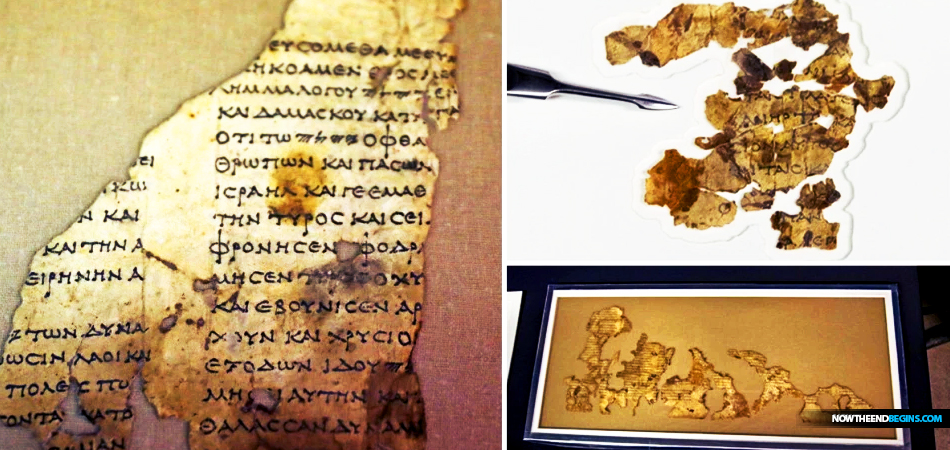
Some 1,900 years ago, Jewish and Christian refugees fleeing the Romans made their way to the Judean Desert. Among the belongings they carried with them were scrolls featuring the biblical books of Zechariah and Nahum.
The discovery of 1,900-year old scripture portions is an incredible revelation, but it becomes stunning when you realize that they were scripture portions held by first century Jewish and Christian believers, to keep them from falling into the hands of the evil Roman empire. The very same Roman empire that two centuries later would unleash the Roman Catholic Church upon the world, ushering in a thousand years of the Dark Ages.
"These are the things that ye shall do; Speak ye every man the truth to his neighbour; execute the judgment of truth and peace in your gates: And let none of you imagine evil in your hearts against his neighbour; and love no false oath: for all these are things that I hate, saith the LORD." Zechariah 8:16,17 (KJB)
Here in the 21st century, the Roman empire and the Vatican are quite busy raising up the One World Religion of Chrislam, and the very scrolls that are bubbling back up to life are the same scripture that pronounces the coming destruction of the Whore of Babylon. Aren't the end times wonderful? They are if you're a bible believer.
2,000-year-old biblical texts found in Israel, the 1st since Dead Sea Scrolls discovered in 1947
FROM THE JERUSALEM POST: Two millennia later, fragments of those texts have reemerged, the Antiquities Authority (IAA) announced Tuesday. It is the first such discovery since the Dead Sea Scrolls were found in 1947 and the early Fifties. The inhospitable environment was considered a safe haven as the war between the Roman Empire and the Judean rebels led by Shimon Bar Kokhba raged around 130 CE. Jews found shelter in the caves and brought what they thought they needed for their new life.
In recent decades, the caves have been targeted by looters eager to find artifacts to sell on the private market. For this reason, a few years ago, the IAA, in cooperation with the Civil Administration’s Archaeology Department, launched a rescue operation to survey all the caves in the area. The findings, which include not only the biblical fragments, but also dozens of artifacts dating back as early as 10,000 years ago, have been astounding.
“More than 80 fragments of different sizes have been uncovered, some of them carrying text, some not,” Dr. Oren Ableman from the IAA Dead Sea Scroll Unit told The Jerusalem Post. “Based on the script, we dated them to the end of the first century BCE, which means that by the time it was brought to the cave, the scroll was already a century old.”
The researchers ascertained that the artifacts matched other fragments uncovered several decades ago and preserved at the IAA laboratory. They belonged to a scroll featuring the biblical Book of Zechariah, written in Greek, except for God’s name, which was marked in paleo-Hebrew.
“This was probably a way to show the importance of the name of God,” Ableman said.
The new discovery is particularly groundbreaking because one of the excerpts that was deciphered presents a version of Zechariah that was never encountered before, he said.
Verses 16 and 17 of the eighth chapter of Zechariah read: “These are the things you are to do: Speak the truth to one another, render true and perfect justice in your gates. And do not contrive evil against one another, and do not love perjury, because all those are things that I hate – declares the Lord.” In the fragment, the word “gates” is replaced by the word “streets.”
“We had never seen this before,” Ableman said. It is not uncommon for texts appearing on the Dead Sea Scrolls to be different than the biblical text we know today. Scholars rely on these differences to understand more about how the canonized version of the Bible developed.
“In this manuscript, we can see the effort of the translators to remain closer to the original Hebrew compared to what happened with the Septuagint,” Beatriz Riestra of the IAA Dead Sea Scrolls Unit said, referring to the earliest Greek translation of the Bible from the third century BCE.
The practice of leaving God’s name in Hebrew was already found in other Dead Sea Scrolls fragments, as well as in several manuscripts from more recent periods from the Cairo genizah, a collection of hundreds of thousands of documents kept in the storeroom of a synagogue in the Egyptian capital, she said.
Together with the manuscript, the archaeologists found several coins minted by the Jewish rebels under Bar Kokhba’s leadership, carrying the writing: “Year 1 for the redemption of Israel.”
“Coins are an expression of sovereignty,” Donald T. Ariel, head of the IAA’s Coin Department, told the Post. “Minting coins meant to be free.” The bronze coins feature a palm tree and a vine leaf.
“At the time, the palm tree had become the quintessential symbol of Judea. The Romans themselves put the symbol also on their Judea Capta coins,” Ariel said, referring to a series of coins minted by the empire to commemorate their victory in the region. READ MORE
No comments:
Post a Comment